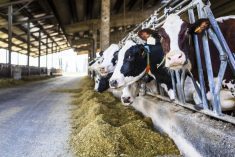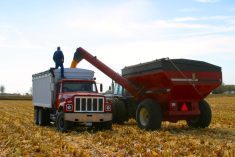Efforts to reduce the Canadian beef industry’s environmental footprint are paying off, new research shows.
“Improved production and feed efficiencies, crop yields and management strategies have led to reduced emissions in Canadian beef production,” said Tim McAlister, research scientist with Agriculture and Agri-Food Canada (AAFC) and principal investigator of the research study. “And, compared to 30 years ago, Canadian producers are now able to produce more beef with fewer cattle and less land.”
Over the past year and a half, AAFC, Environment Canada and the Beef Cattle Research Council (BCRC) have been examining the true environmental footprint of the Canadian beef industry by analyzing how greenhouse gases (GHG) associated with production have changed between 1981 and 2011.
Read Also

Mazergroup’s Bob Mazer dies
Mazergroup’s Bob Mazer, who helped grow his family’s company into a string of farm equipment dealerships and the main dealer for New Holland machinery in Saskatchewan and Manitoba, died July 6 from cancer.
“One kilogram of Canadian beef created 15 per cent fewer GHG emissions in 2011 compared to 1981,” said McAlister.
The report’s findings indicate a 13 per cent decrease in carbon dioxide over the 30-year period, as well as a 15 per cent decrease in methane, and 16 per cent decrease in nitrous dioxide.
“We found that nearly three-quarters of GHG emissions were stemming from enteric methane produced during digestion. And so, as production systems have become more efficient, cattle are managed in ways that promote faster growth and are reaching slaughter weight sooner, which means they are spending fewer days ruminating, producing methane and generating manure.”
Emissions
McAlister said research shows that nearly 80 per cent of methane emissions came from the cow-calf sector.
“This is due to the fact that most breeding herds spend the majority of their life cycle consuming forage-based diets, which produce more methane compared to grain-based diets,” he said.
Along with reduced emissions, researchers found great strides in the sector’s ability to produce more beef with fewer animals and less land.
“We found that Canada was able to produce 32 per cent more beef in 2011 than 1981, mainly due to higher carcass weight. Slaughter steers were 29 per cent heavier and heifers were 45 per cent heavier than in 1981,” said McAlister. “These advancements say a lot about the research community’s ability to find more efficient production methods, at the same time this progression is certainly a credit to the investments being made into research and development and the industry’s ability to adopt the technology.”
The study states that in 2011 it required 29 per cent fewer cattle in the breeding herd, 27 per cent fewer in slaughter cattle and 24 per cent less land to produce the same amount of beef, compared to 1981.
“In the cow-calf sector, a focus on nutrition has improved growth and reproductive performance. More females will be getting pregnant and successfully weaning calves and therefore, fewer heifers need to be retained as replacements, causing the breeding herd to be smaller,” said McAlister.
In the feedlot, McAlister says that increased heifer carcass weight is mainly due to growth promotants that overcame the biological disadvantages that heifers have relative to steers.
“Another factor is that on many farms, improvements are also being made in feed crop yields, allowing the production of the same amount of feed on less land,” he said.

Research methods
The study was conducted mainly through gathering and analyzing data from a number of sources including Statistics Canada, the Canadian Beef Grading Agency, Canfax, as well as large-scale producer surveys.
“This 30-year time frame was selected as it correlated well with Census of Agriculture data from Statistics Canada,” said McAlister. “We looked at the entire production system from the cow-calf operation to the feedlot and emissions were estimated using a cradle-to-farm gate, life-cycle assessment. This is based mainly on Holos, a Canadian whole-farm emissions model.”
Cull dairy cows and dairy steers that entered feedlots were considered to produce beef but veal calves were not.
Researchers also considered a wide range of cow herd winter-feeding management practices and production scenarios, as well as regional differences in diets.
Industry reaction
As beef production’s impact on GHG is often vastly overstated, many in the sector are excited to have scientific data to bring to the conversation.
“Producers have always said that we are good stewards of the land, we always try and do what is best and it hurts us if we don’t. So, I think that it is great to have this report to show the efforts that are being made,” said Melinda German, general manger of the Manitoba Beef Producers. “Beef producers are really forward thinking and proactive. It is great that we now have something that shows this in numbers. It also justifies how important research is and reflects the sector’s constant drive for improvement.”
This study comes on the heels of a proposed increase to the National Beef Checkoff, a motion that would allocate further producer dollars into research and development.
According to German, the increase has been widely supported by Manitoba beef producers.
“We have had a lot of producers comment on the increase to the National Checkoff through discussion at our district meetings and what we have heard is a lot of support for the increase,” said German. “We know what it is going to cost to support a strategic plan that was developed for the entire country, in order to support and advance this sector over the next five years, and I think that this report just echoes how important that investment is.”
Many in the sector have also been eager for a benchmark in order to properly chart the course moving forward.
“Unfortunately, perceived concerns of negative environmental impacts of beef often overshadow the beneficial impacts of the beef industry,” said Tim Oleksyn, chair of the Beef Cattle Research Council. “Beef producers are inherently motivated to be more efficient, which most often has social, economic and environmental benefits. Now that we have resource use and GHG emission benchmarks, we can move forward as an industry and more strategically target our efforts to improve.”
German agrees in the value of a benchmark and foresees future reports holding similar positive outcomes.
“I think that there is really going to be no end and because our industry is always changing,” said German. “I think we will continue to see good-news stories like this in the future, but I also think that there will be times where the news isn’t as positive but that is also helpful in navigating us to direct resources.”
Future research
Published in the journal of Animal Production Science in late December, this is the first report to come out of a five-year study being conducted at the University of Manitoba and AAFC Lethbridge.
As for future research studies, McAlister believes this positive trend will continue but notes that it will also depend on continued adoption of new techniques and consumer support for technology advancements.
“I think that we will continue to see these efficiencies improve, however, that will also depend on the public’s allowance of technology advancements, such as antibiotic and hormone use, as well as implants,” said McAlister. “In our next research phase we will be assessing the areas of biodiversity, provision of ecosystems services and water use.”
Researchers will also be looking at how production management systems that grow grasses and legumes sequester carbon and actually reduce GHG. A report from the second phase of research is expected in 2018.
Data from this initiative will also be incorporated into the Canadian Roundtable for Sustainable Beef, the first-ever sustainability assessment that will look at 2013 as a benchmark to evaluate the industry’s social, economical and environmental impact.




















